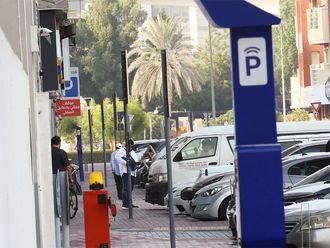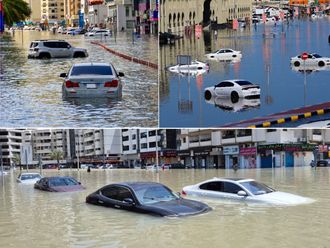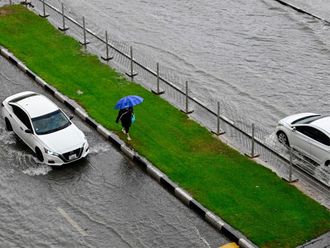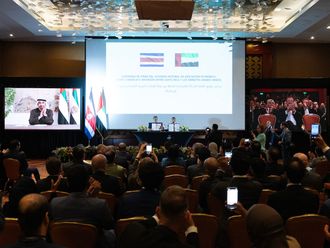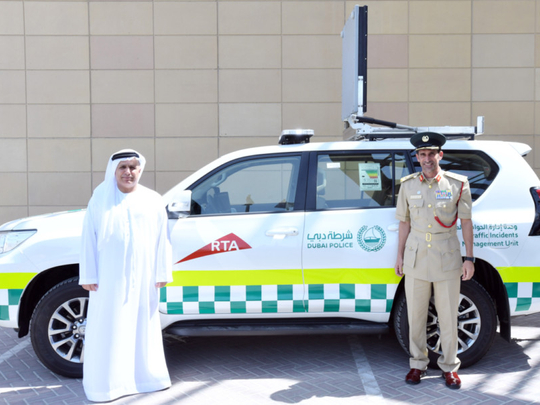
Dubai: Accident sites are expected to be cleared in 10 minutes, reducing traffic jams by 25 per cent as a new Traffic Incidents Management (TIM) system has been rolled out on Dubai’s Shaikh Mohammad Bin Zayed Road.
Covering a stretch of 70 kilometres the TIM will have dedicated accident and vehicle breakdown response vehicles every 13 kilometres on the national expressway that connects Dubai with Abu Dhabi in the south and Sharjah in the north.
A joint venture of the Roads and Transport Authority (RTA) and Dubai Police, the TIM was launched on Sunday by Mattar Al Tayer, Chairman of the Board of Directors and Director-General of Roads and Transport Authority (RTA), and Major General Abdullah Khalifa Al Merri, Commander in Chief of Dubai Police, rolling out specially-equipped vehicles to be stationed at five locations along Mohammad Bin Zayed Road.
“The ultimate objective of this move is to make Dubai a safe and stable city that cares for the protection of lives and properties,” said Al Tayer, following the launch.
Fitted with advanced technologies such as interactive screens and communication devices, the TIM units will cater to vehicle breakdown, rapid intervention at the emergency sites and surrounding roads, and the handling of minor accidents that do not warrant the presence of the police.
It will also carry out detours in case of accidents or breakdowns, assist road users, lend assistance to the police at site and protect parked vehicles.
Expected to cut down delays by up to 35 per cent, the accident response units will also remove vehicles involved in traffic accidents and restore traffic movement back to normal immediately.
“The scheme is intended to ensure rapid deployment for clearance of vehicles involved in minor incidents or experiencing breakdowns on roads. The underlying objective of the scheme is to fend off potential snarls, streamline traffic flow at the accident site, and avoid secondary accidents triggered by sudden congestion,” said Al Tayer.
He added that the Mohammad Bin Zayed Road was selected due to high intensity of traffic movement on the highway, especially during peak hours, and the high frequency of minor incidents and vehicles breakdown witnessed by the road.
According to Major General Al Merri the police units will investigate major injury-associated accidents, report traffic offences, provide judicial support to the incidents unit, monitor traffic cameras and undertake clearance of casualties among others.
“The RTA will provide technical support to the traffic unit, study traffic diversions, and manage the timings of traffic light as well as the virtual messaging signs and tactical traffic diversions. It will also monitor the traffic movement, develop response plans, monitor cameras at site, and prepare the infrastructure at the selected trial sectors,” said Al Merri, highlighting different roles played by the RTA and Dubai Police.
He added that comprehensive traffic management studies were carried out before the trial and a manual for coping with accidents has been developed.
According to statistics, Dubai experiences about 250,000 vehicle breakdowns and 200 minor traffic incidents each year, which the TIM programme aims to cut down by 35 per cent.
How it works?
■ System will ensure quick arrival of emergency response teams
■ Offers alternative roads, diversions and other mitigating measures
■ System to slash time taken to clear crashed vehicles, detect accidents
■ Ensure rapid deployment of alternatives before congestion builds up
■ Help avoid occurrence of secondary accidents
■ Speedy assistance in cases of vehicle breakdown
What it does?
■ Dedicated accident response vehicles stationed at 5 locations
■ Traffic Incident Management units at every 13km
■ Project is expected to reduce snarls and expenses by 25 per cent
■ Accident clearance time to reduce by 35 per cent
■ Accident scene to be cleared within 10 minutes
Traffic in numbers
■ Accidents in Dubai cost the economy Dh1.8 billion annually
■ More than 50 per cent of traffic jams are triggered by road mishaps
■ Dubai loses Dh3.5 billion annually in traffic congestions
■ 51 per cent is the contribution of accidents to Dubai’s annual loss due to congestions
■ In more developed cities, contribution of accidents to annual congestion loss is 25 per cent
■ 1.7 million vehicles use Dubai roads daily


